Poultry, Fisheries & Wildlife Sciences
Open Access
ISSN: 2375-446X
ISSN: 2375-446X
Research Article - (2022)Volume 10, Issue 3
Adaptation to climate change in general and particularly to climate variability in pastoralism is receiving increasing attention. This study assessed the impacts of climate variability on livestock watering and the subsequent adaptation strategies developed by breeders in the agro-pastoral area of Gogounou, Benin. Monthly climate data (rainfall and temperature) from 1985 to 2015 were analyzed using Mann Kendall and Pettitt tests. In addition, primary data on local perceptions of climate variability, its impacts and adaptation strategies in relation to livestock watering were collected through focus group discussions. Our results indicate an increasing trend of 7 mm/year in rainfall and 0.029˚C/year in temperature as well as a break in 1997 and 2002 in the rainfall and temperature series respectively. Consistent with these trends, respondents reported higher temperatures, longer dry spells, and an increase in rainfall intensity over short periods as the common perceptions of climate variability. Water stored in reservoirs for livestock watering during the dry season still meets water demand but is depleting as a result of higher evaporation. Livestock is exposed to heatwaves and water stress while journeying to reservoirs far from lodging places. Good-quality fodders are reported to be less abundant due to recurrent dry spells, excessive heat and extensive agriculture. To cope with these threats, water resources management strategies including the construction of small water ponds nearby lodging places by and only for autochthons pastoralists are developed. Migration towards wetter regions (southern and central Benin) and investment in the regeneration of grassland are other strategies. Efforts should be made in constructing water reservoirs nearby livestock areas and to better maintain existing ones for improving livestock watering.
Livestock watering; Climate variability; Perceptions; Agro-pastoral areas
The livestock sector plays a key role in food supply and food security [1]. Livestock products (meat, milk and eggs) contribute up to 15% and 31% of the global per capita calorie and protein supply [2]. As a supplement to crop production, the livestock sector plays an important role in the socio-economic development of rural households. It contributes about 40% of agricultural value-added [2,3]. It was reported that the livestock sector provides 50% of the value of agricultural output globally and one-third of the value in developing countries [4]. In Africa, pastoralists and agro-pastoralists constitute about 25% of the population and livestock sector remains a major contributor to rural livelihoods and the national economies of many West African nations [5]. Despite this pivotal place in the economy of West African countries, the sector faced several challenges. One of these challenges is climate change which is nowadays a major concern for livestock systems worldwide [1]. Livestock systems operate under a wide range of environmental conditions, causing production to be increasingly affected by climate change. The potential impacts of climate change on livestock include depletion of water availability [6-9] poor production and quality of feed crops and forage [10-12] animal growth deficiency and milk production reduction, reproductive disorders [13].
In Benin, livestock breeding is the second-largest economic activity after crop production, particularly in the northern regions of Alibori and Borgou [14,15]. The severe drought of the 1970s, which caused high ruminant mortality, compelled the government of Benin to promote the construction of agro-pastoral reservoirs for livestock watering and agricultural development. Notwithstanding these actions, low water storage, and water scarcity due to climate change remain limiting constraints to agro-pastoral development in Benin [16-18].
Being the less watered area in Benin, yet an area of intense agro-pastoral activities, the Benin Portion of the Niger River Basin (BPNRB) has been supplied with 141 agro-pastoral water reservoirs [19-21]. Gogounou, one of the districts of the basin has the largest number of agro-pastoral water reservoirs. Out of the 141 reservoirs scattered in the 11 districts of the BPNRB, about 20% are located in the district of Gogounou. The upper northern region of the country, which holds more than 50% of the national livestock is among the most exposed to the change in climate due to the extreme weather conditions [22,23]. Hence, many studies were carried out in Northern Benin with the aim of assessing climate change impacts on livestock production [24,25]. These studies mostly focused on herders’ perceptions and adaptation to climate change, livestock management, and socioeconomic features. Some of the limitations of these studies are the non-combination of climate trend analysis with population’s perceptions in assessing climate change impacts on livestock production. Moreover, little attention was paid to livestock watering at the water reservoirs level and to what extent stakeholders of reservoirs management are acting.
Against this background, the present study is aimed at assessing climate variability impacts on livestock watering and local adaptation strategies in the agro-pastoral area of Gogounou. The remainder of this paper is organized into three main sections. (i) Assessing meteorological data-based climate trends over the research area, (ii) documenting the perceptions of stakeholders (breeders, farmers, reservoir local managers) on climate variability, and (iii) analysing climate variability impacts on livestock watering and adaptation strategies developed to cope with it.
Study area
Gogounou, the study area, is one of the thirteen cities of the BPNRB. It is located at the south of the Alibori department between 10˚33 'and 10˚57' north latitude and 2˚15 and 3˚15 east longitude and made up of six (06) sub-districts (Figure 1). The climate of Gogounou is of the tropical type with a unimodal rainfall pattern made of two distinct seasons, a rainy season from May to October and a dry season from November to April (Figure 2). Temperature over the period 1980-2015 varies between 18˚C and 38˚C. The area is watered by two (02) important tributaries of the Niger River, the Sota River and the Alibori River located in the East and West respectively. The main economic activities in Gogounou are agriculture, livestock breeding, and trade. Gogounou city is a breeding area with a herd composed especially of cattle, in constant evolution leading to the opening of three (03) livestock markets in that city [26]. Cattle at Gogounou were estimated at 77970 heads in 2004 [27]. A study carried out in Benin by the General Water Directorate (DGEau) in 2008, showed that almost 60% of water reservoirs for agricultural uses in the whole country are included in the Benin portion of the Niger River basin with Gogounou having the largest number. Livestock watering is the main purpose of the reservoirs’ construction.
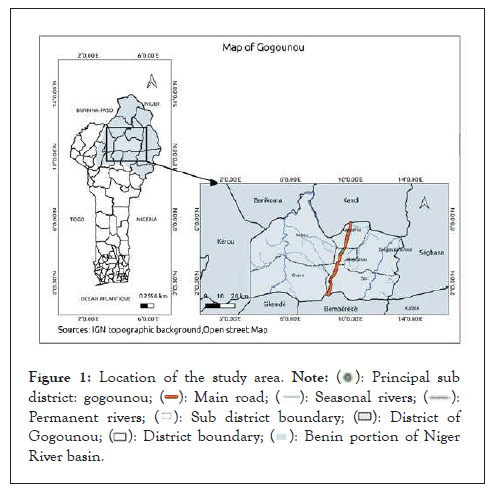
Figure 1: Location of the study area.  district: gogounou;
district: gogounou;  Permanent rivers;
Permanent rivers;  District of Gogounou;
District of Gogounou;  Benin portion of Niger River basin.
Benin portion of Niger River basin.
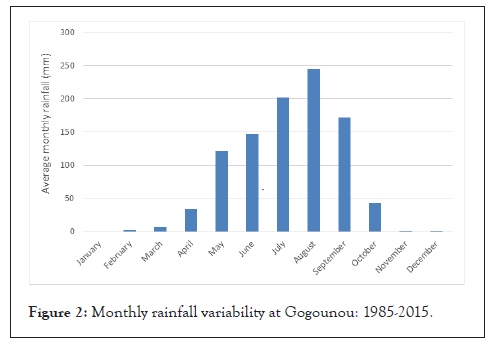
Figure 2: Monthly rainfall variability at Gogounou: 1985-2015.
Data
Two sets of data are used in this study namely climate and survey data. 1) Climate data include monthly rainfall and monthly maximum and minimum temperatures data of Kandi station collected from the Benin Meteorological Agency over the period 1985 to 2015. This period was chosen, first because climate variability analysis requires a minimum of 30 years of data length and also because it takes into account the opening year of water reservoirs. 2) Survey data include the perception of reservoirs stakeholders on the manifestations of climate variability at Gogounou, its impact on livestock watering and adaptation strategies developed.
Trends in climate data
Mann-Kendall and Pettit tests were applied to identify trends and detect breakpoints in annual rainfall and maximum and minimum temperatures series. In addition, the Student test was applied to check the significance of the difference between the average values of the two periods detected by the Pettitt test. Mann-Kendall and Student tests were performed in R 3.6.2. Pettitt test was performed in Chronostat 1.0. A brief description of the three tests is given hereafter.
Mann Kendall test
Mann–Kendall is a rank-based nonparametric test for detecting a monotonic trend in a time series. The method was originally used by Mann and the test-statistic distribution was subsequently derived by Kendall and then polished by Hirsch [28-30]. It is applicable for non-normally distributed data, which are often encountered in hydrology or climatology, and is robust against outliers [31]. The null hypothesis H0 is that a data series is serially independent and identically distributed with no trend. The alternative hypothesis, Ha, is that the data follow a monotonic trend.
The Kendall test statistic S is calculated according to;

Where xj and xk are the annual data values in years j and k, j>k respectively. ‘n’ is the dataset record length.

S is an approximately normal distributed random variable with a mean of 0 and the variance VAR(S).

Where p is the number of the tied groups in the data set and tj is the number of data points in the jth tied group. The statistic S is approximately normal distributed provided that the following Z-transformation is employed.

The presence of a statistically significant trend is evaluated using the Z value. A positive Z indicates an increasing trend, a negative value a decreasing trend.
Pettitt’s test
The approach after Pettitt is commonly applied to detect a single change-point in hydrological or climate series with continuous data [32]. It tests the null hypothesis H0: the T variables follow one or more distributions that have the same location parameter (no change), against the alternative hypothesis Ha that a change point exists.
The time series is subdivided at time t, and the test determines if the mean of the subseries before t is statistically different than the mean of the subseries after t. Given a series of T observations, the test statistic Ts is computed by considering all possible subdivisions (t=1,…T). The time t at which the change point is most likely to occur is identified by considering


And sgn (Z) = 1 if Z >0; 0 if Z = 0 and -1 if Z <0; Z= xi-xj
The significance level associated with Ts is computed using Equation 7

Where p is the probability of detecting the breakpoint. A p-value less than the significance level of 0.05 are identified as a significant change of point in the time series considering a 5% significance level.
Student t-test
The t-test is used to determine the significance of the difference between the means of two samples X1 and X2 assumed to be independent and distributed according to a normal distribution, n1 and n2 being respectively the two samples’ sizes. In this study, the t-test is used for comparing the means of the two periods, before and after the breakpoint. The student test statistic t is defined by the formula

With S the weighted variance of the two samples

The absolute value of t obtained is compared with a value read from the Student-Fisher table for a given number of degrees of freedom v such that

An absolute value of t calculated greater than that read on the Student-Fisher table indicates that there is a significant difference between the two means [33]. The difference between the means is interpreted as being significant if the calculated absolute value of t is greater than the value read on the Student-Fisher table at the threshold α=0.05 and very significant if it is greater than the value read at the threshold α=0.01.
Perceptions on climate change manifestation and impacts on livestock watering and adaptation strategies
The perceptions on climate change manifestations and impacts on livestock watering at the reservoirs level and adaptation strategies, have been collected through a focus group discussion targetting the reservoirs stakeholders. Out of the 23 reservoirs built at Gogounou, six were surveyed (Table 1 and Figure 3). For each surveyed reservoir, one focus group discussion was conducted with the reservoir management committee, breeders and farmers using the reservoirs for livestock watering. That makes a total of six focus group discussions. Beside, delegates of the villages where the reservoirs are located, as well as NGOs managers working at Gogounou in the agro-pastoral sector, were also interviewed. A total of 68 took part in the focus group discussion and 12 in the individual interviews. A guide questionnaire was used for the purpose.
| Reservoirs | District | Opening year | Storage capacity (m3) |
Frequency of livestock drinking |
|---|---|---|---|---|
| Nawari | Gogounou-centre | 2002 | 192000 | Twice a day |
| Kérou- bagou | Bagou | 2004 | [50000-100000] | |
| Sori | Sori | 1995 | [50000-100000] | |
| Gbandarou | Gogounou-centre | 2002 | [50000-100000] | |
| Sorikantakpara | Sori | 1999 | [25000-50000] | |
| Ouèrè | Gogounou-centre | 2001 | [50000-100000] |
Table 1: Water reservoirs selected for surveys.
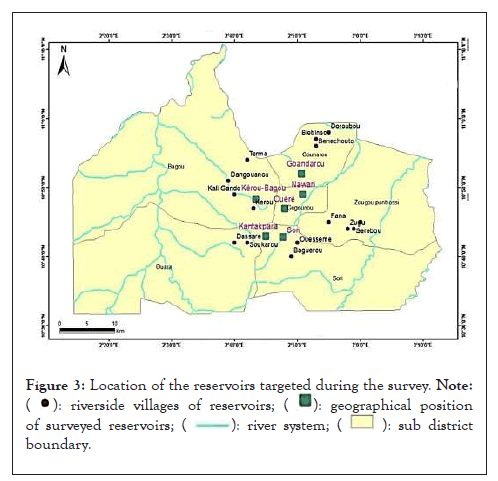
Figure 3: Location of the reservoirs targeted during the survey. Note: 


 boundary.
boundary.
Climate trend (Rainfall)
Trends analysis: The Mann Kendall test reveals an increasing trend in rainfall at Gogounou over the period 1985–2015 which is statistically significant at a 5% significance level. It provides further details on the results of the Mann-Kendall test applied to the rainfall series in Table 2 and Figure 4.
| Mann Kendall Test | |||||
|---|---|---|---|---|---|
| Parameter | P-value | Kendall z statistic | Trend | Significance level | Sen’s slope |
| Rainfall | 0.027 | 0.282>0 | Increasing | 5% | 6.94 |
Table 2: Statistics of the Mann-Kendall test applied to Rainfall series.
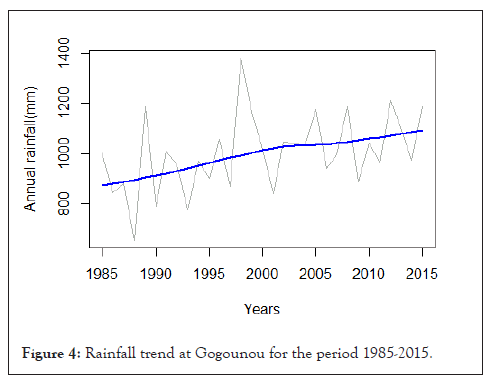
Figure 4: Rainfall trend at Gogounou for the period 1985-2015.
Breakpoint analysis: Pettitt test shows the existence of breakpoint in 1997 in the rainfall series over the period 1985 -2015 statistically significant at a 10% significance level. It shows the results of the Pettitt test applied to the rainfall series in Table 3 and Figure 5.
| Pettitt test | |||||
|---|---|---|---|---|---|
| P-value | Breakpoint | Significance level | Period | Mean (mm) | Standard deviation (mm) |
| 0.001 | 1997 | 10% | 1985-1997 | 915.01 | 137 |
| 1998-2015 | 1065.22 | 131 | |||
Table 3: Statistics of the Pettit test results applied to rainfall series.
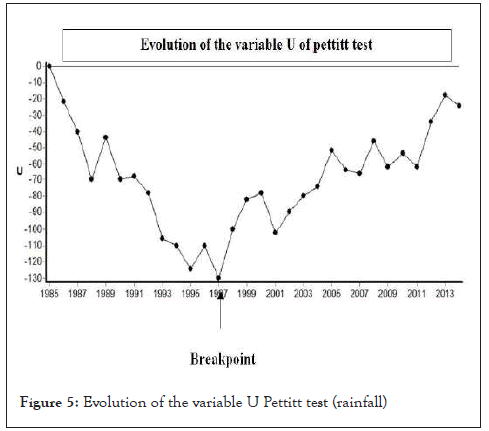
Figure 5: Evolution of the variable U Pettitt test (rainfall).
The t-test confirms that the two periods (1985-1997 and 1998-2015) identified by the Pettitt test are significantly different. The analysis suggests that Gogounou is subject to an increasing trend in rainfall marked by a breakpoint in 1997 indicating the beginning of a more humid period in Figures 4 and 5, Tables 2-4.
| t-test | ||
|---|---|---|
| Period | Means (mm) | Pvalue |
| Period 1:1985-1997 | 915.013 | 0,0001<0.05 The null hypothesis is rejected. therefore there is a significant difference between the two means |
| Period 2: 1998-2015 | 1065.22 | |
Table 4: t student test to compare the means before and after breakpoint in rainfall.
Trends and breakpoint analysis of minimum and maximum temperatures series
Mann Kendall test applied to the minimum and maximum temperature series reveals a significant increasing trend in minimum and maximum temperatures over the period 1985-2015. The Pettitt detects a breakpoint in 2002 significant at a 5% significance level in the thermometric series (Tmax and Tmin). It shows the results of the Mann Kendall and Pettitt tests applied to the minimum and maximum temperatures (Table 5 and Figures 6-9).
| Mann Kendall Test | Pettitt Test | |||||||
|---|---|---|---|---|---|---|---|---|
| Variables | P value | τ Kendall | Significance level | Trend | Sen’s slope | P value | Breakpoint | Significance level |
| Tmax | 0.01 | 0.327>0 | 5% | Increasing | 0.0294 | <0.0001 | 2002 | 1% |
| Tmin | 0.0002 | 0.469>0 | 5% | Increasing | 0.0292 | <0.0001 | 2002 | 1% |
Table 5: Statistics of the Mann Kendall and Pettitt tests applied to Tmax and Tmin.
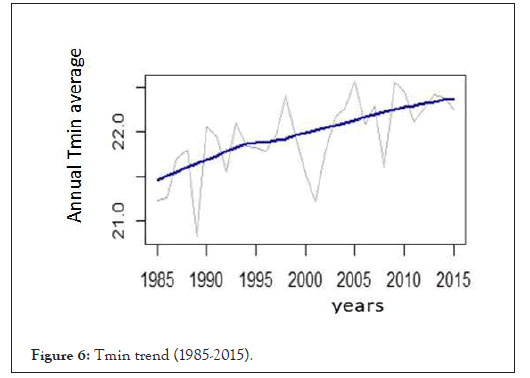
Figure 6: Tmin trend (1985-2015).
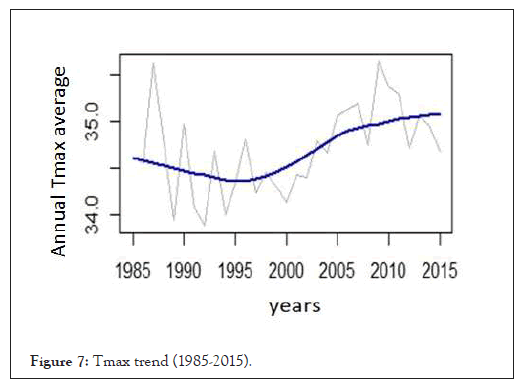
Figure 7: Tmax trend (1985-2015).
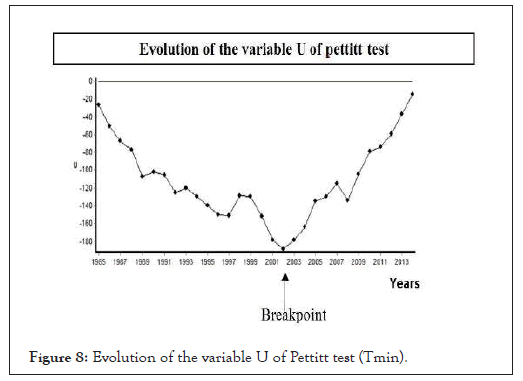
Figure 8: Evolution of the variable U of Pettitt test (Tmin).
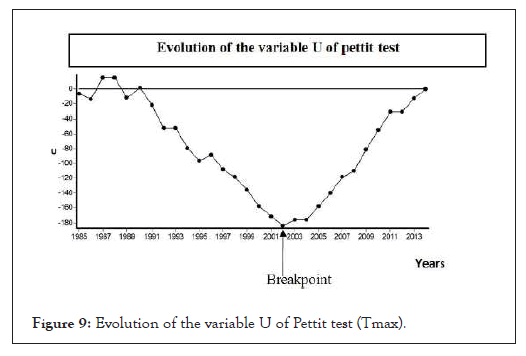
Figure 9: Evolution of the variable U of Pettit test (Tmax).
Table 6 shows the results of the t-test applied on the T max and Tmin series for the two periods identified by the Pettitt test.
| Parameters | Period | Means | p-value | Comment |
|---|---|---|---|---|
| Tmin | 1985-2002 | 21.71 | 0.0001<0.05 | The null hypothesis is rejected. therefore there is a significant difference between the two means at a 5% level of significance |
| 2003-2015 | 22.29 | |||
| Tmax | 1985-2002 | 34.44 | 0.0001<0.05 | |
| 2003-2015 | 35.20 |
Table 6: t student test to compare the means before and after breakpoint in the Tmin and Tmax series.
The t-test confirms that the two periods (1985-2002 and 2003-2015) identified by the Pettitt test in the Tmax and Tmin series of Gogounou are significantly different. An analysis of Figures 6-9 and Tables 5 and 6 shows that Gogounou city is subject to an increasing trend in temperatures marked by a breakpoint in 2002 in temperatures series.
Perceptions on the manifestation and impacts of climate variability at Gogounou
Regarding the manifestations of climate variability at Gogounou, the main ones listed by the respondents are dry spells, an increase in rainfall frequency over short periods, late rainy season onset, and rising temperatures (Figure 10).
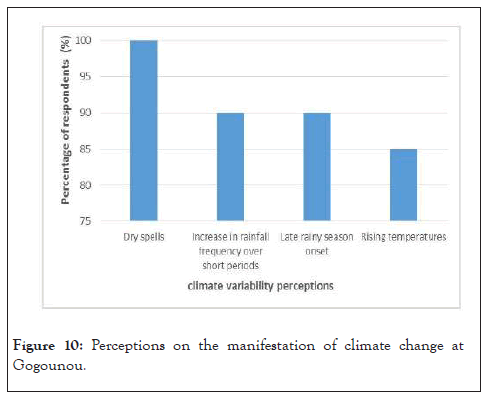
Figure 10: Perceptions on the manifestation of climate change at Gogounou.
The perception of dry spells as a manifestation of climate variability is shared by all the respondents. The increase in temperature presented above based on meteorological data analysis is consistent with perception as 85% of the respondent’s perceived rising temperature as a manifestation. This is also true for rainfall because 90% of the respondents reported an increase in rainfall frequency over short periods.
Climate variability impacts on livestock watering and adaptations strategies
Water reservoirs are the main sources of water for Livestock (Figure 11).
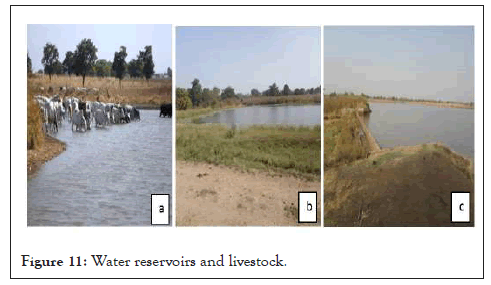
Figure 11: Water reservoirs and livestock.
Livestock watering, the main activity around the reservoirs is done twice a day. Though very exposed to evaporation, according to the breeders, water stored in reservoirs still meets livestock water demands, even peak demands during the dry season. Furthermore, some of the breeders especially those exploiting the three reservoirs surveyed at Kerou-Bagou and Sori have to lead livestock over long distances daily under intense heatwaves to reach the reservoirs. In the context of an upward trend in temperatures, this has and will continue to have negative impacts on livestock health. To cope with, the adaptation strategy consists of the digging of pits by pastoralists not far from their lodging place for rainwater harvesting (Figure 12). The pits store rain waters for a long period (approximatively five-six months) because they are dug around wetted areas. The depth of these pits varies from 2 m to 4 m, their width is about 2 m, and their length can reach 12 m, meaning a storage volume of about 48 m3 to 96 m3. They are used for livestock watering during the rainy season till the beginning of the dry season (Figure 12). However, the pits are only reserved for autochthon breeders, unlike the water reservoirs which are also used by non-autochthons. Apart from livestock watering, fodder is also affected by the observed climate variability at Gogounou. It was reported by the NGO UDOPER (Union Départementale des Organisations Professionnelles de Ruminants) and by the breeders that the fodder availability is depleting in terms of quality and quantity causing the massive departure of breeders towards the central and southern parts of Benin. The depletion of fodder mentioned is mainly due to the destruction of grasslands as a result of extensive agriculture and climate variability (rainfall and temperature) limiting fodder productivity. In their efforts to adapt to the issues of forage depletion and water reservoirs far from lodging places, pastoralists are supported by some NGOs working in the city. In that sense, the NGO UDOPER provides a portfolio of support including i)raising their awareness of the harmful effects of climate change; ii)reforestation with fodder trees; iii) the creation of artificial grasslands; iv) drilling of wells equipped with dewatering systems and drinking troughs.
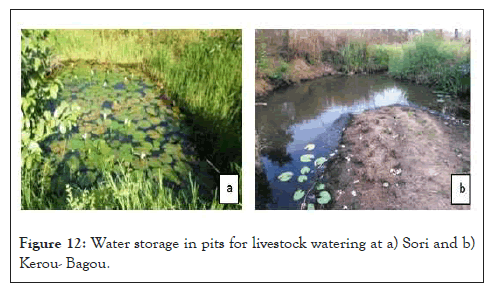
Figure 12: Water storage in pits for livestock watering at a) Sori and b) Kerou- Bagou.
Climate trend
The analysis of climate variability at Gogounou revealed the existence of a significant breakpoint in 1997 in the rainfall series from 1985 to 2015 at Kandi station. This breakpoint comes in addition to the breakpoints of the years 1968 to 1972 identified by several authors in Benin and several countries in West and Central Africa [34-36]. In Benin, the breakpoint between 1968 and 1972 was highlighted and especially in the Beninese basin of the Niger River [37]. While the breakpoints of the years 1968-1972 mark the existence of a decreasing trend in rainfall from 1970, the one in 1997 identified at Gogounou, marks the existence of an increasing trend of rainfalls in this area about 30 years after the first breakpoint of 1970. The study revealed a breakpoint in 1998 at Kandi station with an increasing trend of rainfall over the period 1970-2010 [20].
Climate perceptions, impacts
The study showed that climate change perceptions are dry spells, late rainy season onset, rising temperature and an increase in the frequency of rainfall over short periods. The perceptions of the respondents corroborate the findings of many authors such as Idrissou in the dry tropical area in Benin, Dimon at Kandi and Banikoara, Djenontin at Banikoara and Malanville (included in the Benin part of Niger River basin), Zakari, Nouatin in the Alibori department, in the northern and central part of Benin [38-41]. For instance, it was reported that the local populations in the Alibori department (Benin) perceived climate change through dry spells in the rainy season, the late rainy season onset, excessive heat, and the erratic spatial distribution of rains. Almost the same perceptions were observed in the southern part of Benin by Adégnandjou in the Zou catchment, Houssou-goe in the Couffo catchment, and Agossou, Vissoh in the Oueme catchment [42-45]. For instance, it was reported that farmers in the Zou catchment perceived climate change by increasing temperature, rainfall disturbances (rainfall delays, early cessation, erratic rainfall distribution etc.), shortening of the small dry season, and sometimes strong winds. In addition, Akponikpè et al. through a study in five countries of sub-Saharan West Africa on farmers' perceptions noted that the onset of the (first) rainy season was perceived by farmers to be late. Conversely, the season cessation was mentioned to be earlier, making the season duration to be shorter. All these various studies may lead to the assertion that the climate is getting warmer and the rainfall are erratically spatially distributed over time with an increase in the frequency of of dry spells.
Adaptation strategies to the impact of climate on livestock watering
Water harvesting in pits dug by the pastoralists (Figure 12) besides their lodging place, is a strategy to cope with the long walking distance to reach the reservoirs. These pits are dug around wet areas to ensure their durability and for harvesting more water. These results are consistent with the findings of authors like Djohy in north Benin, Kate at Banikoara found that the water holes are dug in the shallows for mobilizing more water and also, that the pastoralists exploit groundwater through boreholes and the over digging of wells. Providing on-site drinking water is very important for ensuring the good productivity of livestock [14,25]. This is highlighted in Ethiopia, as a way to reduce animal stress and loss of energy and as a result increase milk and meat production [46,47]. On the other hand, a rise in temperatures noted at Gogounou added to long distances travelled daily by livestock towards some water reservoirs, exposes them to more heat stress. This result is in agreement with the findings in India [48]. Indeed, revealed that there is a negative balance in livestock because during high temperatures conditions, animals have to walk long distances to search for water or feed [48]. This situation causes thermal stress and may lead to physiological and behavioural responses in an animal affecting livestock production. It was argued that high temperatures reduce feed intake, lower milk production, and lead to energy deficits that may lower cow fertility, fitness and longevity [49]. Moreover, most species perform best at temperatures between 10˚C and 30˚C, and at temperatures above 30˚C, cattle, and sheep reduce their feed intake by 3%-5% for each 1˚C increase [50].
The respondents also mentioned the depletion of fodder in terms of quantity and quality as a result of climate variability (excessive heat, dry spells,) and extensive agriculture. These results are consistent with the findings of at Banikoara (Benin), Burkina Faso, Kenya [14,51]. In Kenya, the shortage and the poor quality of fodder are some of the direct impacts of climate change on livestock in Kenya [52]. In Burkina pastoralists pointed out climate change (drought and flood) as the driver of the reduction of the availability and quality of fodder [51]. To face the issue of the depletion of fodder quantity and quality, transhumance is one of the strategies adopted by the pastoralists at Gogounou. Some of them move towards the south and central parts of Benin to get more fodder. This result aligns with those in Burkina who highlighted that that migration is one of the strategies of pastoralists to adapt to climate variability. For coping with fodder shortage in northern Benin, Kate also indicated the use of crop residues and the creation of fodder reserves by the pastoralists. Current climate variability at Gogounou offers the possibility to foresee the future. The increase in temperatures will trigger an increase in livestock water demand and competition for water is likely going to happen. However, the increasing temperature has also positive feedback. The emergence, spread and distribution of livestock diseases may all be affected by higher temperatures affecting the rate of development of pathogens or parasites, shifts in disease distribution that may affect susceptible animal populations and effects on the distribution and abundance of disease vectors. Excessive heat reduces the cycle of the parasite. On the other hand, this study calls for action. In this context of climate variability at Gogounou, other water reservoirs should be built for storing more water for various uses. The point is that water reservoirs, when well exploited, offer multiple opportunities to increase the means of subsistence and to improve the food security, thus allowing the sedentarization of local populations and attracting new populations [53,54]. They appear as a vector of social change [55,56]. However, the maintenance of the existing reservoirs must be systematic and regular which will guarantee their effectiveness and their sustainability. Furthermore, the surroundings of the water points must be properly managed to avoid the development conditions of certain internal parasites which have an imperative need for humidity to assure their cycle and to re-infest the animals. To do this, it will be necessary to install concrete drinkers at the various water reservoirs [57-59].
This study reveals that Gogounou, the city with the largest number of water reservoirs within the Beninese Section of the Niger River, has experienced significant climate variability over the last 30 years. This variability is marked by an increase in rainfall and temperatures with a breakpoint in 1997 and 2002 respectively in the rainfall and temperatures series. Local population perceptions of climate change match with meteorological data analyses, especially with regard to excessive heat and rainfall intensity. Dry spells, increasing temperatures, and increasing rainfall frequency over a short time slice are the most perceived manifestations of climate change. As a result, livestock faces heat stress and fodder reduction but water demand is met. Local adaptations are developed by the pastoralists to facilitate livestock watering namely: construction of small ponds in wetted areas nearby their lodging places, and transhumance towards central and southern part of Benin. Aside that, the pastoralists are strengthened by NGOs, in their actions to cope with climate change impacts on livestock sector. That proves the importance of livestock sector in this area. Water reservoirs which are of great importance in this activity deserve more attention and actions ensuring their sustainability. For local development, livestock sector cannot be dissociated from water resources management and climate change. In the future, increase in evapotranspiration as a result of higher global warming combined with livestock growth may lead to unmet livestock water demand and thereby induce more competition and pastoralists' displacements. Future works should address such research problem.
The second author is grateful to the ClimapAfrica Program for providing resources for his postdoctoral study partly used for this study.
Citation: Kevin SS, Félicien BD, Rosaine YN, Luc SO (2022) Climate Variability and Livestock Watering: Impacts and Adaptation in the Agropastoral District of Gogounou in Benin. Poult Fish Wildl Sci. 10:213.
Received: 25-Nov-2022, Manuscript No. PFW-22-20441; Editor assigned: 28-Nov-2022, Pre QC No. PFW-22-20441 (PQ); Reviewed: 12-Dec-2022, QC No. PFW-22-20441; Revised: 19-Dec-2022, Manuscript No. PFW-22-20441 (R); Published: 26-Dec-2022 , DOI: 10.35248/2375-446X.22.10.213
Copyright: © 2022 Kevin SS, et al. This is an open-access article distributed under the terms of the Creative Commons Attribution License, which permits unrestricted use, distribution, and reproduction in any medium, provided the original author and source are credited.